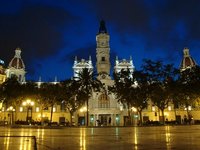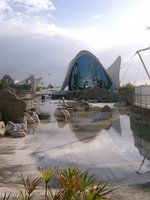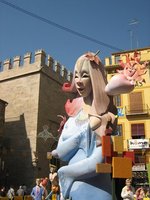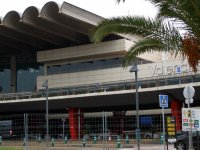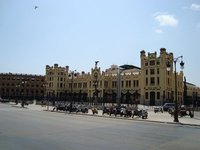Valencia (Spain)
Travel Guide Europe Spain Valencia Valencia
Introduction
Valencia is a popular sea-side city on the Mediterranean coast of Spain. While the beach is an obvious drawcard for the city, Valencia's charm is its emblematic combination of the old and new: traditional Baroque, Gothic and Neo-Classical architecture is contrasted with the ultra-modern City of Arts and Sciences, a massive educational complex designed to symbolise the Space Age. The city itself has about 800,000 inhabitants, but the total urban area is almost twice that size and the metropolitan area almost three times as big, making it one of the bigger ones in Spain. The image of a modern city is further boosted, by hosting a round of the Formule 1 Championship, in the harbour area, and being the host of the America's Cup (a sailing competition) in 2007 and 2010.
Sights and Activities
City of Arts and Sciences
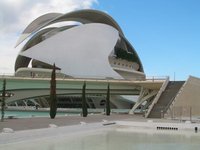
Valencia 2008 - City of Arts and Sciences
© Derdia
The City of Arts and Sciences (Ciudad de las Artes y las Ciencias) was designed by the architect Santiago Calatrava and Felix Candela. It is a series of Six buildings in a contemporary style in the dried river bed of the now diverted River Turia. This place is worth walking around by day or night because of its stunning design. There are many buildings dedicated the arts located in the complex including:
- Palau de les Arts Reina Sofía (Queen Sofia Palace of the Arts) is an amazing opera house and cultural centre in the city. There are several different stages that can fit between 400 and 1,700 people.
- Hemisfèric, contains an IMAX theatre, Planetarium and Laserium. The building was designed to reflect the human eye, which is fitting as the main activities here are visual.
- Umbracle is a nice walkway and garden area. On the upper level there are also temporary expositions. Under the Umbracle is a car park
- Museo de las Ciencias Principe Felipe (the Museum of Sciences Prince Felipe) is a museum dedicated to the sciences. There are exhibits ranging from spy science all the way to biometrics. The museum seperates the different expositions, so that you can take your own route. It is also very much inviting you to participate, making it a good place to take kids.
- Agora is the name of the newest addition, which is a place that will be used as a venue for special events
- Oceanogràfic is one of the largest aquariums in Europe with more then 45,000 animals, which include sharks, penguins, dolphins, sea lions, beluga whales and walruses. The park is divided into ten areas, including, the tropics, the Artic and the Antartic to reflect different kinds of habitats.
The ticket prices are as following (2016):
- Hemisfèric: €8,80 (reduced rate €6,85)
- Museo de las Ciencias Principe Felipe: €8,80 (reduced rate €6,20)
- Oceanogràfic: €28,50 (reduced rate €21,00)
- Hemisfèric + Museo de las Ciencias Principe Felipe: €12,60 (reduced rate €9,60)
- Oceanogràfic + Hemisfèric: €30,90 (reduced rate €23,40)
- Oceanogràfic + Museo de las Ciencias Principe Felipe: €29,70 (reduced rate €22,55)
- Oceanogràfic + Hemisfèric + Museo de las Ciencias Principe: €36,90 (reduced rate €28,00), this ticket is valid for 3 days, but each sight, can only be visited once.
Reduced rates are applicable for children between 4 and 12 (children between 0-3 have free entrance), retired people and pensioners. for large families, and holders of student cards (and local Spanish youth cards), there is a discount of 15%, large groups get a special rate as well.
latest information on: www.cac.es
Beaches
- Las Arenas is the beach closest to the city, easily reached by metro and tram.
- Malvarosa Beach Is the most famous urban beach in Valencia, 1,000 metres long. All covered by thin, golden sand. It shows a more lively atmosphere because of the quantity and quality of its services around. With a boardwalk surrounding all of it.
- La Patacona is the best choice for those who want to go the beach but do not want to leave Valencia, and also be a little bit away from all the noise, bars, restaurants. It is the quiet beach option. It is also close to a typical garden and valencian landscape and from the zone where you can taste the most famous horchatas in Valencia.
Other Sights and Activities
- Basílica De La Virgen De Los Desamparados is a nice gothic style church.
- The Cathedral of Valencia is a stunning cathedral with a great dome and a long history.
- Lonja de la Seda (Silk Exchange) is a stunning late gothic style civil structure built from 1482 to 1548. The designer Guillem Sagrera made the building at the height of the cities economic power in the 15th century.
- Plaza Ayuntamiento is the largest square in the city and contains the town hall, the post office, a classical cinema and many restaurants and bars.
- The Torres de Serranos and the Torres de Quart are two old gates, that remain from the time that the old city was still walled, both can be visited.
- Mercado Central is a large covered market, so typical of Spain. For buying fruits, meat, fish and cheese many locals come here. A bit smaller but more beautiful, and now turned into a mini centro commercial is the Mercado de Colón
- Museum of Belles Artes is a fine arts museum, with paintings of many of the old masters.
- Albufera is the most famous natural park in Valencia. An spectacular unique place called "Mirror of the Sun" by the arabs. Perfect corner for a calm boat ride. But also for when you get tired, you will be able to taste some of the most famous paella, in El Palmar. The zone where Valencians eat their most famous dish. And for a perfect finish you may take a walk throughout El Saler.
- Miguelete Tower (Micalet as it is known by the locals) is, possibly, the best viewpoint in the whole city since centuries ago. The Bell Tower of the Cathedral has been witness of the local history and yet it allows us to see the boundaries of the city. Is from the XIV century, gothic style and it has 207 steps if you want to get to the roof.
Events and Festivals
Fallas
Falles is a city tradition that celebrates Saint Joseph's Day on the 19th of March, and the days leading up to that date. Each year every neighbourhood in the city of Valencia has a group of people that create a falla, which is then burnt. Only the best of one will survive. The entire city (and the rest of the comunidad) comes out for the festival in their Fallas dresses and it can get very crazy. Every day at 2 p.m. the Mascleta takes place of the Plaza del Ayuntamiento. This involves a lot of firecrackers and people from every neighbourhood trying to impress each other. As a visitor it is best to watch this from a safe distance.
La Tomatina
La Tomatina is a festival that starts the week before the last Wednesday of August in the town of Buñol which is 38 kilometres outside of Valencia. For the week before people party and there is a famous cooking contest the night before the fight. On the last Wednesday of August the massive tomato fight begins with 20,000 to 40,000 tourist coming to participate in this epic battle in a town of only 9,000 people.
Weather
Valencia has a typical Mediterranean climate with warm and dry summers and mild but wetter winters. Summers last from late May to September when average daytime temperatures are mostly between 26 °C and 30 °C while nights are warm at 18 °C to 21 °C. Winters last from December to February when during the day the temperatures are between 16 °C and 18 °C and nights average about 7 °C or 8 °C. Annual precipitation is low at around 450 mm. Most of the rain falls from September to December and summers (June to August) are driest.
| Jan | Feb | Mar | Apr | May | Jun | Jul | Aug | Sep | Oct | Nov | Dec | |
|---|---|---|---|---|---|---|---|---|---|---|---|---|
| Avg Max | 16.1 °C | 17.2 °C | 18.7 °C | 20.2 °C | 22.8 °C | 26.2 °C | 29.1 °C | 29.6 °C | 27.6 °C | 23.6 °C | 19.5 °C | 16.8 °C |
| Avg Min | 7 °C | 7.9 °C | 9 °C | 10.8 °C | 14.1 °C | 17.9 °C | 20.8 °C | 21.4 °C | 18.6 °C | 14.5 °C | 10.4 °C | 8.1 °C |
| Rainfall | 36 mm | 32 mm | 35 mm | 37 mm | 34 mm | 23 mm | 9 mm | 19 mm | 51 mm | 74 mm | 51 mm | 52 mm |
| Rain Days | 6 | 6 | 6 | 7 | 8 | 5 | 2 | 4 | 6 | 7 | 6 | 7 |
Getting There
By Plane
Valencia Airport (VLC) is the 8th busiest airport in Spain. The airport has flights to about 15 European countries with about 6 million passengers a year. Air Nostrum has flights to a number of Spanish cities, including Madrid, Bilbao, Seville and Málaga, and others include Casablanca, Dubrovnik, Madeira and Lisbon. Ryanair flies to/from Bari, Bologna, Brussels, Cagliari, Dublin, East Midlands, Frankfurt, London, Madrid, Milan, Pisa, Rome and Weeze (near Düsseldorf). Other airlines have flights to places like Amsterdam, Paris, Geneva, New York, Prague, Zürich, Bucharest, Stuttgart and Marrakech.
To/from the airport
Valencia airport is situated adjacent to the Autovía A-3 highway which connects Valencia with Madrid and is also close to the Autovía A-7 coastal route to Barcelona. It is also well served by public transport. The airport is connected to the city by a regular bus, which takes 45 minutes, a shuttle service, which takes 20 minutes, and the metro (lines 3 and 5), which takes 20 minutes. The metro also goes to the railway station and port of Valencia (costs € 2,90 for a single ticket, note that the airport is located in Zone B). Taxis and car rental agencies are both readily available at the airport and there are thousands of long-term and short-term parking places.
By Train
Estación Del Norte is the main train station in town and is designed in an art deco style, situated on the south end of the old city and next to the Plaza de Torros, it is a nice place, to walk in to have a look, even when you don't have to catch a train. Renfe is Spain's national railway company and there are highspeed trains travelling to and from Madrid and Barcelona, among other cities.
By Car
From Madrid, Valencia can be reached by taking the A-3 highway. From Barcelona, you take the A-7 going south along the coast. The A-7 continues to Alicante and Cartagena. The A-23 connects Zaragoza with Valencia.
By Bus
Eurolines has buses to other destinations in Spain, Morocco and many European countries/cities. From inside Spain Alsa Bus is one of the biggest companies, that provides links to Valencia, including from Barcelona, Murcia, Alicante, Málaga and many more places.
By Boat
Balearic Islands
- Acciona Trasmediterránea has ferries from Valencia to the Balearic Islands, like Mallorca and Ibiza. Balearia and Iscomar offers roughly the same connections as well.
Getting Around
By Car
Apart from taking a taxi, using your own car is not really advisable. It can get crowded and parking is expensive.
By Public Transport
Valencia Metro has six lines that make it very easy to get around the city, even to the airport. A one way tickets costs €1.60. EMT has buses all around the city.
By Foot
Most of Valencia can easily be explored on foot, though the beaches and City of Arts and Sciences requires some form of public transport, taxi or bike.
By Bike
Valencia is one of the most bicyle friendly cities in Spain, there are many bikelanes in the city. One thing that makes biking in Valencia easier then in other Spanish cities is the fact that most of the city is flat.
Do You Bike has bikes for rent for €10 a day, during weekdays, and €15 during the weekend.
Valencia has a bicycle plan. You can take a bike from one of the many stands, and return the bike to another one. To be able to do this, you need to buy an 'abono', which can be bought at one of the stands. (for one week €10, after which lending a bike is free up to 30 minutes, and if you need it longer, for a small extra charge.)
Eat
Eating is one of the most cool things that you can do in Spain. Although Valencia is not well know because of tapas or other Spanish dishes, it is famous because of its paella. It's the regional dish and it's one of the most famous in Spain. It's made with rice, saffron adding with seafood or rabbit and chicken or vegetables. It tastes really good, and it's a relatively healthy food.
An specifically preparation typical from Valencia Albufera is the “all i pebre” a stew with potatoes, hot pepers, garlic and eels. Also famous is the fish in sauce. Classic dish from the fishing zone in Valencia, containing fish, potatoes, garlic and hot pepper.
Undoubtately the most common fruit in Valencia is the orange, harvested during autumn and Winter, but it is available for the whole year. Its excellent quality(probably the most famous in the world) and the different existent variations make this fruit something present in every valencian home. But we cannot forget about the vegetables in Valencia, since this is a region famous for its garden zones., Valencian salad(classic salad with tomato, lettuce and onion is a very used dish to accompany the main one.
Drink
In Valencia, you can try "horchata" which is a white drink, absolutely sweet, highly recomended for summer and the hot days in Spain.
Bars and Nightlife
Valencia has a great nightlife. The alternative/bohemian bars and nightclubs are mainly located in the Carmen area, while the student nightlife is concentrated around Blasco Ibanez. The more mainstream weekend nightlife is around the Canovas and Juan Llorens areas. During the summer it is possible to party on the beach at Port and Malvarossa Beach.
Learn
Keep Connected
Internet
Internet is widely available within Spain. Most airports have wifi-zones and in most towns there are internet cafés or shops where you can use internet for a fixed price. Wi-Fi points in bars and cafeterias are available after ordering, and most hotels offer Wi-Fi connection in common areas for their guests.
Phone
See also: International Telephone Calls
The international access code for Spain is +34. The emergency number for police, ambulance and the fire brigade is 112.
In cities you can find plenty of public phones, and 'locutorios'. The latter are small shops where you can use the phone and use internet. Most of them also sell prepaid cards for mobile telephones. These shops are used a lot by foreigners to call to their mother country.
The main mobile network operators in Spain are Yoigo, Vodafone, Movistar and Orange, as in most of Europe voice and data coverage is generally good in urban areas however it can be patchy in rural locations. Cheap mobile phones (less than €50) with some pre-paid minutes are sold at FNAC or any phone operator's shop (Vodafone, Movistar, Orange). Topping-up is then done by buying scratch cards from the small stores, supermarkets, vending points (often found in tobacco shops) or kiosks.
Post
If you want to post a card, you can head to the post office (Correos). The Spanish post is not yet as efficient as colleagues in other countries so receiving a card can take a bit longer than the number of days that it should take. On the website of Correos, you can find the locations of nearby post offices.
Post offices are generally open from 8:30am to 2:00pm, although times will vary according to the size of the city/town and the main post offices might be open until the early evening. Most will also open again on Saturday mornings, but in the smaller towns will close as early as 12 noon. When posting a letter, look for a yellow box and, if possible, post at the post office itself where there will also be divisions for local, national and international mail. Be prepared for long queues at the post office. This is why tobacco shops sell stamps and many will also have the facility to weigh packages. Standard letters/postcards of up to 20 grams sent within Spain are €0.34. However, non-standard letters/postcards of up to 20g are €0.39. Letters/postcards of 20 to 50 grams are €0.45. In the case of international shipping, the price is €0.64 to most countries within Europe for standard envelopes (letters/postcards) up to 20g, for a few European countries and outside Europe it is €0.78. If you want to send a package you are probably better off with a private courier company like TNT, DHL or UPS, as they offer quick and reliable services against competitive prices.
Accommodation in Valencia (Spain)
We have a comprehensive list of accommodation in Valencia (Spain) searchable right here on Travellerspoint.
Contributors
 Utrecht (37%)
Utrecht (37%)
from https://utrecht.travellerspoint.com Herr Bert (34%)
Herr Bert (34%) wowlocals (15%)
wowlocals (15%)
from Wowlocals
as well as Lavafalls (12%), dr.pepper (1%), Emilianogu (1%), KellieBarnes (1%)
Valencia (Spain) Travel Helpers

wowlocals
Ask wowlocals a question about Valencia (Spain)Because I am a Valencia native, worked for years for a travelling company, and I am very aware of every corner of it.
This is version 76. Last edited at 14:30 on Feb 4, 19 by Utrecht. 10 articles link to this page.

Except where otherwise noted, content of this article is licensed under a Creative Commons Attribution-ShareAlike 3.0 License

